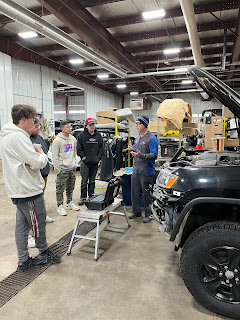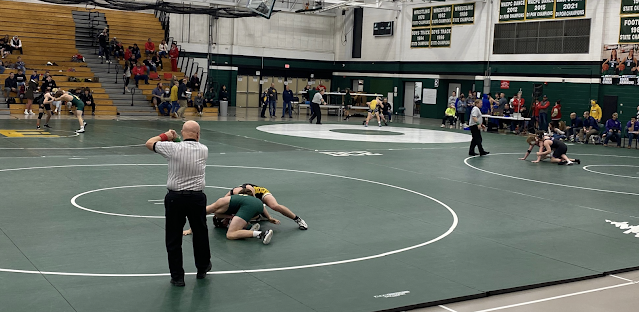D.C. Everest Senior High School Staff Update
Weekly Happenings
Congratulations to these students for earning another Microsoft Certification! The following students have earned their Microsoft Office Specialist - PowerPoint Associate certification: Anson Jiang, Ashley Khang, Bryan Watters, Ethan Hanke, Fiona Vermote, Haley Clark, Hanna Rickert, Jakob Landwehr, Jarret Imlach, Jordyn Jakubek, Kadin Kurtz, Kenny Thao, Mai Lee Yang, Olivia Gipp, Parker Hurt, Reed Dombeck, and Shouanang Lee.
The STEM Robotics Class and others participated in an industry tour to CTech Manufacturing in Weston on Tuesday, December 21st. CTech is an industry leader in the manufacturing of aluminum carts, cabinets & drawers. CTech products can be found across the U.S. and around the globe in the racing industry, professional athletic leagues, emergency vehicles, military units and service industry. Students learned about Automation Industry 4.0, Youth Apprenticeships, and careers in Manufacturing Production, Engineering, Information Technology, and Sales & Marketing.
Congratulations to Riley O'Connor and Natalie Costa for their 1st and 3rd place finishes in the Voice of Democracy audio essay!!! Please congratulate these students when you see them - Also thank you to Anne Marie Jagodzinski for her mentorship to both of them!
Congratulate Dayton Goralski and Riley Held when you see them. Through their class Creative Marketing Solutions they were able to secure $1,000 in funding for school supplies for the Junior and Senior High School. Great work by Jodi Peterson and these students!
Jazz Band sounded great at Patron's before break!
A huge thank you to all who had a hand in distributing almost 100 meals to families before break - Such an amazing thing accomplished by amazing people!
Curriculum and Instruction
Thank you to Brooke Davis for sharing this article with me before break. Concise way to think about structuring our environments as we close out one semester and start anew.
Six Tips for Cultivating a Trauma-Informed Higher Education Classroom at the Beginning of Each Semester
November 15, 2021
Ashley Herr-Perrin
Collective trauma, in spite of its profound gravity, has granted us an opportunity as educators. Through the devastation of COVID-19 and chaos of various social and political events within the past two years, attention to mental health has encouraged conversation instead of stigmatization (American Psychological Association, 2019). We are also more attuned to the presence of the trauma and toxic stress that many of our students are shouldering, and how their ability to learn can be compromised as a result (National Council of State Education Associations, 2019).
As educators, we remain responsible for creating an optimal environment in which student learning can flourish. When students feel that they are in danger—whether it is real or perceived—tasks such as critical thinking, emotional regulation, processing, and concentration are obliterated in favor of self-preservation. The ability to establish trust becomes complicated if not impossible. Self-efficacy and esteem are often under threat as well. Awareness of trauma and its effects on learning can provide an informative lens through which we can contextualize student behavior and better structure an environment that is responsive to their needs.
There is undoubtedly major cognitive overload for us instructors as we try to establish the tone and structure of our classrooms in addition to delivering material. The thought of trying to incorporate trauma-informed principles into that equation may seem rather intimidating, especially because we have to re-evaluate the needs of the class every semester and modify best practices accordingly. However, many recommendations for trauma-informed educational practices are similar to student-centered teaching techniques with which you are probably already familiar. They can be modified easily with the goals of safety and optimal learning in mind. Below are some strategies you can implement seamlessly into the first week of your course and set the tone for the rest of the semester.
1. Safety
Why it matters: Embracing vulnerability can be extremely difficult for any student, especially for those whose safety has been compromised.
How it works: Be open with students about the classroom being a safe space and what that means. Let them know that the learning process might not always be comfortable, but you will be facilitating it with their mental and emotional health in mind.
Keep in mind: A safe space does not mean avoidance or suppression of potentially difficult conversations in the classroom. Rather, it serves as an environment in which mental and emotional health are recognized and re-traumatization is minimalized, thus allowing for these types of conversations to take place as safely as possible.
2. Trustworthiness and Transparency
Why it matters: Unpredictability and surprises are often trauma-triggers. Trust can be a challenge to build and fragile in maintenance for trauma survivors.
How it works: Use the syllabus as a tool to be very clear about your expectations with assignments, policies, and anything else having to do with the way the class will be managed.
Keep in mind: It is important that students know that confidentiality is respected and exercised whenever possible, but communication in the classroom is not privileged. You are required to report anything that would fall under Title IX provisions as well as other safety concerns. However, let students know that candid discussion is still encouraged and that you can refer them to additional support if needed.
3. Peer Support
Why it matters: A history of trauma-exposure can elicit ongoing feelings of shame and isolation.
How it works: Establish the expectation of peer support up front when you discuss the classroom as a safe space. Start each class with about 5-10 minutes to “shake it off.” During this time, students are welcome to speak about their day or what’s on their mind or anything else that they need to share before diving into class content. Their peers are encouraged to provide verbal support and feedback during these conversations. For example, if a student shares about a particularly difficult day at work, you might pose the question to the rest of the class, “Has anyone else ever experienced this type of situation in the workplace? How did you handle it? What kind of support was helpful?”
Keep in mind: This brief activity serves multiple purposes: to allow disclosure and support within the boundary of a time-frame, assist you in getting a reading about what the students may be carrying with them into the classroom that day, activate engagement and problem-solving skills, and transition students into learning. It is intended to be supportive but should not be used in a clinical manner.
4. Collaboration and Mutuality
Why it matters: Many students have never been asked for their input in classroom decision-making and are resigned to just being told what to do. Relationships with authority figures may also be tainted for trauma-exposed students.
How it works: Provide opportunities for collective input regarding decisions about the classroom. For example, have students design class conduct norms, how everyone will hold each other accountable, and how conduct infractions should be addressed. Let students know that this involves them holding you accountable, too.
Keep in mind: Think of your role as similar to a coach. You can implement structure, leadership, consistency, fairness, and accountability without being authoritarian.
5. Empowerment, Voice, and Choice
Why it matters: Students with trauma exposure often have a fractured sense of self.
How it works: Begin to counter this by working with what positive aspects students are bringing into the classroom instead of what they are lacking. Start with an icebreaker activity where students can showcase their positive traits and build community. Provide them with prompts such as, “What are you good at?” “What do you enjoy?” “What has helped you get to this point in your life?” “How can you contribute to our learning community?” “How can our learning community best support you?” Then, divide students into partners or groups, have them interview each other, and then have members share out to the class. Make sure to offer non-participation or alternative participation as options.
Keep in mind: Traumatized students might not be ready to openly share or could have a difficult time generating positive attributes about themselves. Let them know that they are welcome to email or talk to you privately regarding what they want you to know about them.
6. Cultural, Historical, and Gender-based TraumaWhy it matters: Although not specifically listed in the Diagnostic and Statistical Manual for Mental Disorders [DSM-5], cultural, historical, and gender-based trauma are very much an active part of many students’ lives. Even if students aren’t directly exposed to a particular event, trauma has an especially long shelf-life that can last for multiple generations.
How it works: Consider preparing a welcome statement for the first night of class that speaks to diversity, inclusivity, and the value of belonging in the classroom. Students will know they are seen and accepted no matter their characteristics, struggles, experiences, mistakes, and so on. You might even hear an audible sigh or two of relief after you read the welcome statement.
Keep in mind: Exercising cultural humility will reinforce your commitment to building rapport with students. Be careful to refrain from adopting a “color-blind” approach as this can invalidate the experiences of students who have faced cultural, historical, or gender-based trauma.
Announcements/Week Ahead
Thank you to Tami Mlodik for sharing the following:
Important Dates:
January
3 School Resumes
6 Reality Fair
6-7 Grad ordering by Jostens, lunch hours
10 Grading Table opens
11 Coordinator/Chair Meeting, 3:40-4:40 pm, JH IMC
12 BLT Meeting, Conf Rm 369, 2:50 pm
14 2nd Friday Count during period 2, 9:10-9:15am
15 Senior Ball
17 NO School, PD for Grading
18 Quarter 3 Begins
19 Faculty meeting in IMC, 2:50 PM
26 BLT Meeting, Conf Rm 369, 2:50 pm
26 School Board Meeting, Middle School, 6:30 pm
February
17 Parent Teacher Conferences 3-6:30 pm
17 Week of the 17th - 3 parent contact hours
May
25 Graduation 6-9 pm
Upcoming Field Trips
Field Trips - Field trips are still permitted at this point. Please consider academic and curricular importance when scheduling. If the guidance changes, we will let you know. See Mike Raether if you have any questions. Please submit class list 2 weeks prior to trip.
*NO additional field trips on
- 2nd Friday Count (1/14/22)
- JH Adventure Day??
Field Trip Form from District (click on '2340(A): Field Trip Request' then '2340 (A) Field Trip Request Fillable 5-289-19.pdf. Please write explanation of field trip along with the destination.












































